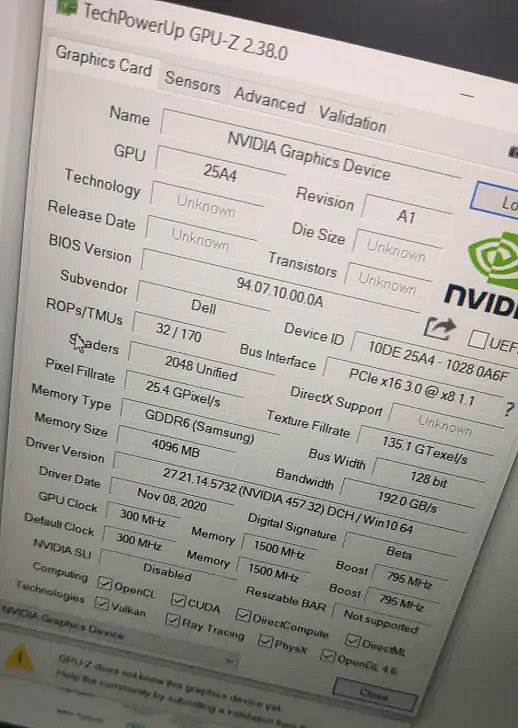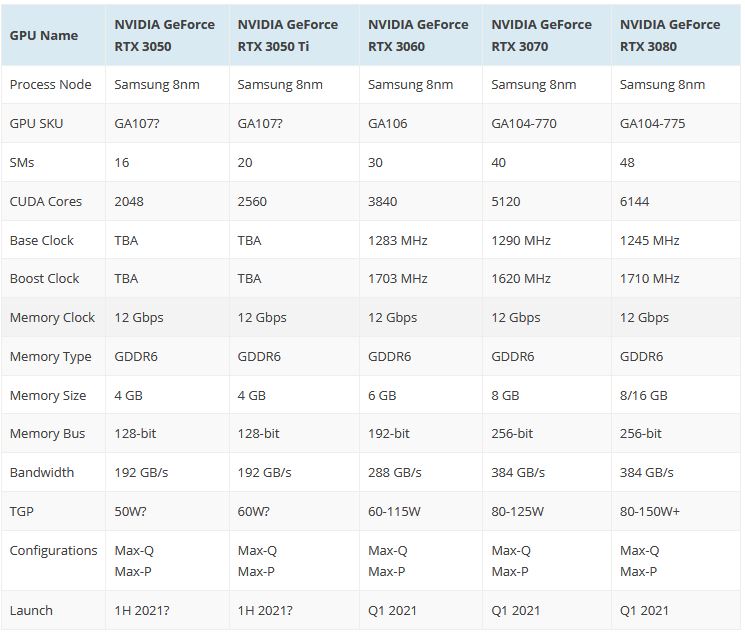
NVIDIA will soon be launching its GeForce RTX 3050 series graphics cards for both desktop and mobility platforms. The GeForce RTX 3050, in particular, has leaked out today in the form of its GPU-z screenshot which was posted over at Bilibili (via Videocardz).
NVIDIA GeForce RTX 3050 Mobility GPU is a budget laptop GPU, Features GA107 GPU With 2048 Cores & 4 GB GDDR6 Memory
The specifications for both NVIDIA GeForce RTX 3050 graphics cards for the mobility platform were leaked out a few weeks back. We were able to confirm the most basic specifications and now we’ve got a more exact look at what they are going to be (at least for the Non-Ti variant). The GeForce RTX 3050 series cards will be targetting the budget gaming segment with desktop cards priced within a sub-$250 US range while the laptops based on these cards will retail at under $599 US considering the RTX 3060 laptops start at $999 US.
The mystery GPU also appears to be part of a Dell laptop. The GPU clock fields show it boosting to 795MHz, which is either a lower clock for testing (an engineering sample) or an aggressive limitation for a Max-Q configuration. Given that the GeForce RTX 3060 in mobile form runs at 1,283MHz to 1,703MHz, it is reasonable to expect the GeForce RTX 3050 in mobile form will be clocked north of 1,000MHz. Or maybe 795MHz is the lower end, and for whatever reason, this Dell system is capping the GPU at what could end up being the official part’s base frequency.

So coming to the specifications, the NVIDIA GeForce RTX 3050 Non-Ti variant is based on the N20Z-QS1-A1 GPU SKU (Ampere GA107) which features 16 SM units or 2048 CUDA cores. GPU-z can’t tell the exact clock speeds that the GPU features and only reports a base clock of 300 MHz and a boost clock of 795 MHz which are a far cry from its final clocks. The GPU also carries 4 GB of GDDR6 video memory which operates across a 128-bit bus at speeds of 12 Gbps, delivering a total bandwidth of 192 GB/s.
The NVIDIA GeForce RTX 3050 GPU was reportedly running on a Dell machine on a PCIe Gen 3.0 interface which suggests it was either running on an AMD Ryzen 5000 or an Intel 10th Gen Comet Lake CPU based notebook considering these are the only two options that offer Gen 3 interface & Intel’s 11th Gen Tiger Lake CPUs are the only notebook offerings that come with PCIe Gen 4.
The other key feature is that the GeForce RTX 3050 Ti is listed as an “RTX” variant. Previously, ray tracing was kept exclusive to **60 series graphics cards and above but this changes with Ampere and now we can get ray tracing on entry-level graphics cards too. However, the pricing of the GPU will be higher with the RTX 3050 Ti expected to be set at around $229-$279 US while the RTX 3050 will cost just slightly below the sub-$200 US range. Expect more details on these cards along with several laptop configurations in the coming months.
Whatever the case might be, this is shaping up to be an interesting part for budget gaming laptops. Bearing in mind that 4K gaming is not the goal, the GeForce RTX 3050 as configured should deliver a decent performance punch above what any current integrated graphics solution can offer, with ray tracing to boot. We’ll have to wait and see how clock speeds actually shake out, though.
NVIDIA GeForce RTX 30 Mobility GPU Lineup:






